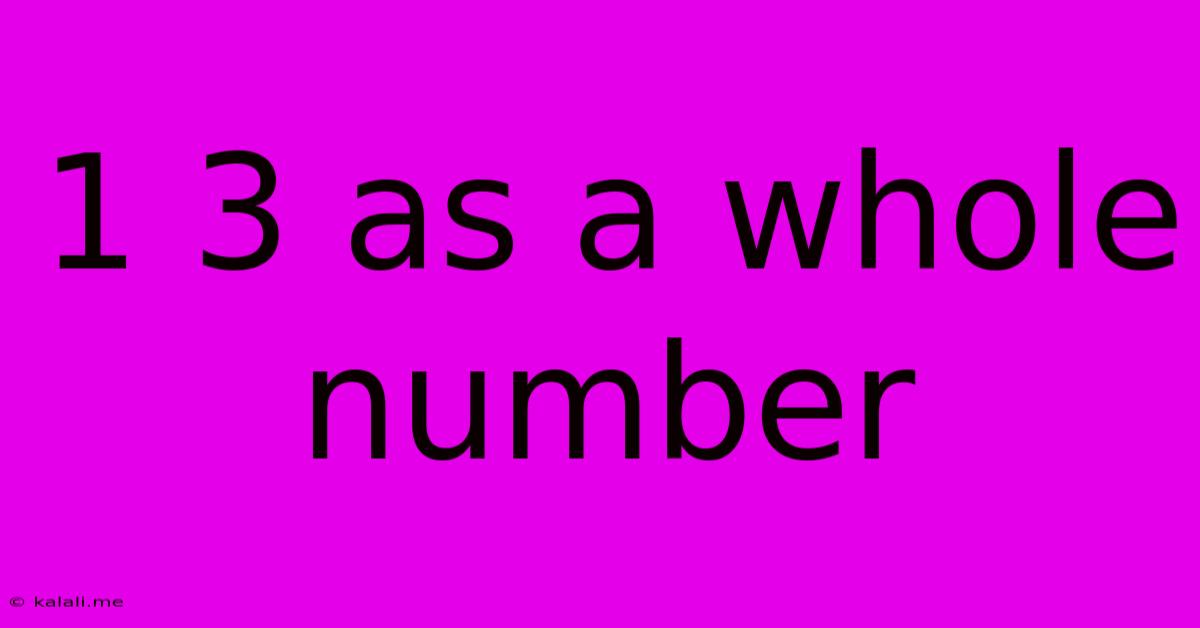1 3 As A Whole Number
Kalali
May 10, 2025 · 3 min read

Table of Contents
Understanding 1/3 as a Whole Number: A Deep Dive
Meta Description: Learn how to represent the fraction 1/3 as a whole number, exploring the concepts of fractions, decimals, and the limitations of expressing fractions as whole numbers. Discover practical applications and common misconceptions.
The question of how to represent 1/3 as a whole number is a deceptively simple one. The short answer is: you can't. 1/3, as a fraction, represents a part of a whole, and a whole number represents a complete unit. This fundamental difference prevents a direct conversion. However, understanding the relationship between fractions, decimals, and whole numbers is crucial to grasping the nuances of this concept.
Fractions, Decimals, and Whole Numbers: A Quick Refresher
Before delving deeper, let's review the basics. A whole number is a non-negative number without any fractional or decimal component (0, 1, 2, 3, ...). A fraction, like 1/3, represents a part of a whole. The numerator (1) indicates the number of parts you have, and the denominator (3) indicates the total number of equal parts the whole is divided into. A decimal is a way of expressing a fraction using base-10 notation (e.g., 0.333...).
Why 1/3 Can't Be a Whole Number
The core reason 1/3 cannot be expressed as a whole number is because it represents a portion less than one whole unit. Three thirds (3/3) would equal one whole number (1), but one third (1/3) is inherently less than one. Trying to force it into a whole number format would fundamentally misrepresent its value.
Representing 1/3 in Other Forms
While 1/3 can't be a whole number, it can be represented in other ways that might be useful depending on the context:
- Decimal: 1/3 is approximately equal to 0.333... (a repeating decimal). The ellipsis (...) indicates that the digit 3 repeats infinitely. This is a precise representation, even though it's not a terminating decimal.
- Percentage: 1/3 is equivalent to approximately 33.33% (again, a repeating decimal). This form is often used to express proportions.
- Rounding: In certain situations, you might round 1/3 to the nearest whole number. However, this introduces an approximation and loss of precision. In this case, it would round down to 0.
Practical Applications and Misconceptions
Understanding the limitations of representing 1/3 as a whole number is important in various fields:
- Measurement: When dealing with measurements, accurately representing fractions like 1/3 is crucial for precision. Rounding might lead to inaccuracies.
- Calculations: Performing calculations involving fractions requires maintaining their fractional form until the final result. Prematurely converting to whole numbers can lead to errors.
- Data Analysis: Representing data accurately often requires maintaining the precision offered by fractions and decimals.
A common misconception is that 0.33 is the same as 1/3. While it's a close approximation, it's not perfectly equal. 0.33 is actually 33/100, which is slightly smaller than 1/3. The difference is small, but it can become significant in complex calculations.
In conclusion, while you cannot express 1/3 as a whole number, you can use its decimal, percentage equivalent, or carefully considered rounding depending on the context. Understanding the distinctions between whole numbers, fractions, and decimals is vital for accurate representation and calculations. Remember to prioritize accuracy whenever possible.
Latest Posts
Latest Posts
-
Words That Start With Y In Science
Jul 12, 2025
-
Prevent An Expressway Emergency By Merging Without
Jul 12, 2025
-
How Many Grams Of Sugar In A Pound
Jul 12, 2025
-
7am To 11am Is How Many Hours
Jul 12, 2025
-
If Your 35 What Year Was You Born
Jul 12, 2025
Related Post
Thank you for visiting our website which covers about 1 3 As A Whole Number . We hope the information provided has been useful to you. Feel free to contact us if you have any questions or need further assistance. See you next time and don't miss to bookmark.